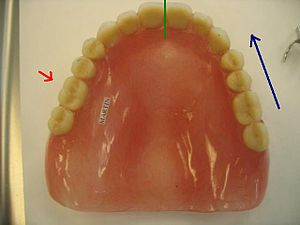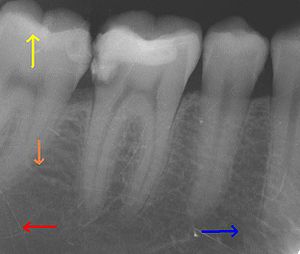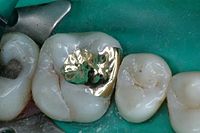- Commonly used terms of relationship and comparison in dentistry
-
There are numerous commonly used terms of relationship and comparison that refer to different aspects of teeth and are frequently utilized in articles about dentistry. Many of them are included below as a sort of glossary to assist with understanding the many articles that include these types of words.
Terms
Anterior refers to the direction towards an individual's lips, as opposed to posterior, which refers to the directions towards the back of an individual's head. The term anterior teeth refers to incisors and canines, as opposed to premolars and molars, which are posterior teeth.
Apical refers to the direction towards the root tip(s) of a tooth, as opposed to coronal, which refers to the direction towards the crown. It may also refer to something relating to the roots, such as apical support. When referring to direction in relation to entities on or of the crown, this term can be synonymous with both cervical and gingival.
Axial refers to a plane parallel to the surface of a tooth. For example, if a drill bur would be inserted into a tooth from any side (proximal, facial or lingual), the depth of the hole is defined by the axial wall of the hole.
Buccal refers to the side of a tooth that is adjacent to (or the direction towards) the inside of the cheek, as opposed to lingual or palatal, which refer to the side of a tooth adjacent to (or the direction towards) the tongue or palate, respectively. Although technically referring only to posterior teeth (where the cheeks are present instead of lips, use of this term may extend to all teeth, anterior and posterior), this term may be employed to describe the facial surface of (or directions in relation to) anterior teeth as well.
Cervical, which simply means neck in Latin (as in cervical vertebrae), refers to the narrowing of the contours of the tooth surface at or near the CEJ, where the crown meets the root. When referring to direction in relation to entities on or of the crown, it is nearly synonymous with both apical and gingival.
Coronal refers to the direction towards the crown of a tooth, as opposed to apical, which refers to the direction towards the tip(s) of the root(s). It may also refer to something relating to the crown, such as coronal forces.
Distal refers to the direction towards the last tooth in each quadrant of a dental arch, as opposed to mesial, which refers to the direction towards the anterior midline. Each tooth can be described as having a distal surface and, for posterior teeth, a distobuccal (DB) and a distolingual (DL) corner or cusp.
 This photo shows an occlusal view of a complete maxillary denture. The green line, indicating the dental midline, is the defining line when it comes to mesial-distal direction. The blue arrow, which indicates a mesial direction, applies to the opposite side as well up until the green line. The red arrow is directly buccal to the right first maxillary molar, and the patient's name (Martin) label is embedded in the resin directly palatal to the same tooth.
This photo shows an occlusal view of a complete maxillary denture. The green line, indicating the dental midline, is the defining line when it comes to mesial-distal direction. The blue arrow, which indicates a mesial direction, applies to the opposite side as well up until the green line. The red arrow is directly buccal to the right first maxillary molar, and the patient's name (Martin) label is embedded in the resin directly palatal to the same tooth.
Facial refers to the side of a tooth that is adjacent to (or the direction towards) the inside of the cheek or lips, as opposed to lingual or palatal, which refer to the side of a tooth adjacent to (or the direction towards) the tongue or palate, respectively. This term is an umbrella term for both the term buccal and labial.
Gingival refers to the direction towards the gingiva (gums), synonymous with cervical and similar to apical. However, locations on teeth already more apical to the interface of the crown and root, referred to as the CEJ, tend not to be described using this term, as it would lead to confusion, as the exact definition is ambiguous. Additionally, this term would not be used when referring to a tooth ex vivo.
Incisal refers either to the direction towards the biting edge of anterior teeth or to something relating to this edge, such as the terms incisal guidance or incisal edge. This is the sister term to occlusal, which related to the analogous location on posterior teeth.
Inferior, as usual, refers to the direction towards the feet of a human's body, as opposed to superior, which refers to the direction towards the head. However, use of these terms should enjoy only limited usage when discussing features of a tooth, as, for example, something more inferior on a mandibular tooth will be situated more superior on a maxillary tooth, as they exhibit an inverted relationship. It is for this reason that the terms coronal and apical are substituted.
Labial refers to the side of a tooth that is adjacent to (or the direction towards) the inside of the lip, as opposed to lingual or palatal, which refer to the side of a tooth adjacent to (or the direction towards) the tongue or palate, respectively. Although technically referring only to anterior teeth (where the lips are present instead of cheeks), use of the term buccal may extend to all teeth, anterior and posterior.
Lingual refers to the side of a tooth adjacent to (or the direction towards) the tongue, as opposed to buccal, labial or facial which refer to the side of a tooth adjacent to (or the direction towards) the inside of the cheek or lips, respectively. Although this term is technically specific to the mandible, it enjoys extensive use in reference to the maxilla as well (see Palatal.)
Mandibular refers to entities related to the mandible.
Marginal may be used to refer to a number of different 'margins' that are involved in dentistry. The edge of tooth structure that is prepared to meet the edge of a prosthetic crown is called a margin, as is the aforementioned edge of the crown; an example of this usage would be "a poorly fitting crown might exhibit marginal leakage." The gingiva and bone that abut the teeth are referred to as 'marginal', as in marginal periodontitis. The bulk of tooth structure on the occlusal surface at the point of contact of posterior teeth is referred to as the marginal ridge.
Maxillary refers to entities related to the maxilla.
Mesial refers to the direction towards the anterior midline in a dental arch, as opposed to distal, which refers to the direction towards the last tooth in each quadrant. Each tooth can be described as having a mesial surface and, for posterior teeth, a mesiobuccal (MB) and a mesiolingual (ML) corner or cusp.
Occlusal refers either to the direction towards the biting surface of posterior teeth or to something relating to this surface, such as the terms occlusal interference or occlusal surface. This is the sister term to incisal, which related to the analogous location on anterior teeth. Restorations are designated by their location on a tooth, and abbreviated as such. Thus, for example, an amalgam restoration on the distal-occlusal of a tooth would be termed a DO amalgam.
Palatal refers to the side of a tooth adjacent to (or the direction towards) the palate, as opposed to buccal, labial or facial which refer to the side of a tooth adjacent to (or the direction towards) the inside of the cheek or lips, respectively. This term is strictly used in the maxilla.
Posterior refers to the direction towards the back of an individual's head, as opposed to anterior, which refers to the directions towards an individual's lips. The term posterior teeth refers to premolars and molars, as opposed to incisors and canines, which are anterior teeth.
Proximal refers to the surfaces of teeth that normally lie adjacent to another tooth. It is an umbrella term which includes both mesial and distal, such as when referring to the proximal surfaces of teeth.
Superior, as usual, refers to the direction towards the head of a human's body, as opposed to inferior, which refers to the direction towards the feet. However, use of these terms should enjoy only limited usage when discussing features of a tooth, as, for example, something more superior on a mandibular tooth will be situated more inferior on a maxillary tooth, as they exhibit an inverted relationship. It is for this reason that the terms coronal and apical are substituted.
See also
References
- Major M. Ash, Stanley Nelson. WHEELER'S DENTAL ANATOMY, PHYSIOLOGY AND OCCLUSION, 8th edition.
Categories:- Dentistry definitions
Wikimedia Foundation. 2010.


